Pole Position
July 1982 (ARC, Japan)
Confession time: Up to this point, I've been content to consider the later reissued versions of the games considered in the NamCompendium to be sufficient for review purposes. I have in fact played games like Galaga, Pac-Man, and Dig Dug in their original arcade format, worn out joysticks and all, but up to this point we have been strictly dealing with games that relied on the sort of inputs that a face button or two and a halfway decent directional pad could replicate.
I mention this up top because Pole Position is a game that is absolutely dependent on experiencing the pure arcade version. It isn't just a matter of the CRT glow or the the tactile feel of sitting in a deluxe version of the cabinet: the game demands a mode of analog input that all but requires the original steering wheel to "get" what this game was doing. I have yet to do this, and actively hunting for this (as will be discussed) complicated three decade old arcade cabinet has proved fruitless so far. I will update this at some point with actual arcade impressions, but for now please accept this caveat emptor.
Pole Position was not even Namco's first attempt to replicate the experience of driving a car. Disallowing Rally-X and its sequel as they were more like aneurysm dispensers than racers, Namco had produced two electromechanical games that explored this space: 1970's Racer, and 1976's F-1 (with Atari). Pole Position may thus be positioned (ahem) as a spiritual successor to these titles.
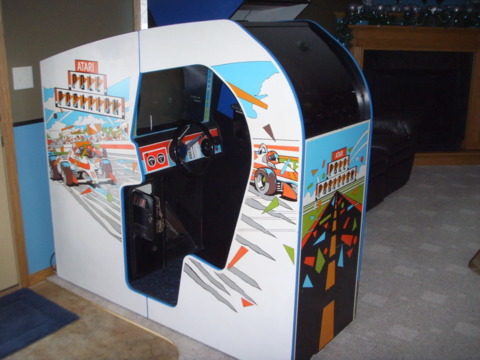
It also marks the return, and arguably the last huzzah, of Toru Iwatani to the game planning role. Iwatani has gone on the record stating that Pac-Man did not enrich him personally, and that his role within Namco as a games designer barely changed in light of the success of his seminal creation. While I cannot speak to his actual pay stubs in the early 1980s, I can work with dates and establish that Nakayama Masaya saw fit to give Iwatani two years to develop his next work. Working alongside hardware designer and programmer Kouichi Tashiro (credited on Galaxian and the Rally-X series) and sound engineer Ohnogi Nobuyuki (Galaga and New Rally-X), Iwatani designed a game that represented a huge departure from his previous works.
It was such a departure, in fact, that it required what may have been the first 16-bit arcade game ever made. It was certainly a NamCompendium First as a game that required 16-bit microprocessors to function. Pole Position operates on three discrete processors: a Zilog Z80 8-bit, and two Zilog Z8002 16-bit processors all working in tandem. These processors were required to handle the game's sprite scaling, stereo audio, and write operations to non-volatile RAM that allowed for high scores to be stored after the machine was powered off, all of which are NamCompendium firsts in themselves.
What did all of this tech combine to produce? A game that feels like it came from the future. A racer that shares more DNA with games like OutRun or Ridge Racer than any of its predecessors.
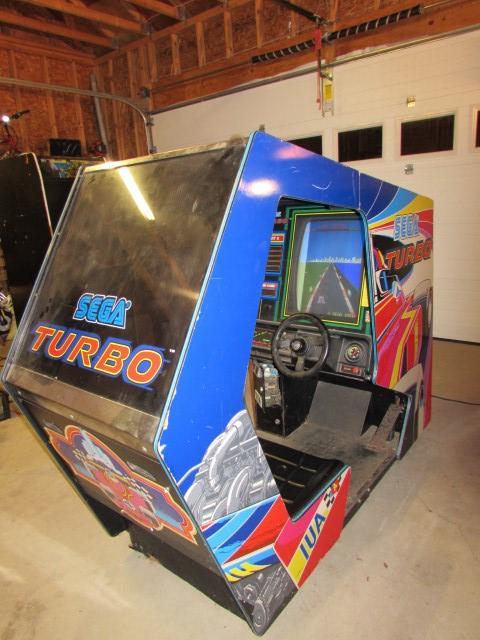
A meaningful point of comparison here would be another contemporary arcade racing game: 1981's Turbo, a Sega joint. Lauded for its graphics at the time, Turbo tasked the player with passing and avoiding opponent vehicles to reach the front of a pack on an ever scrolling belt of road. But whereas Turbo is essentially a game about avoiding traffic, Pole Position is a game about actual driving. Smartly changing gears, maneuvering through turns, and avoiding traffic are essential to making it through the qualifying stage and participating in the actual race portion of the game. This is is why the arcade experience is so essential to Pole Position, as attempting to play this without the non-centering wheel strips away a great deal of the original experience.
The feeling of racing was so important, in fact, that at some point in the development of Pole Position it was decided that not even death by immolation should prevent the player from experiencing. Much like King & Balloon, destroying the player avatar by hitting anything on the track does not end the game. Instead, the player is penalized by waiting for a car to respawn, eating away at the finite amount of time allotted to the player. This design choice informs racing games to the present day, with games like the Mario Kart series substituting player death by bottomless pits for a slow Lakitu-assisted reentry to the race that incentivizes careful and skilled driving without being overly harsh. Needless to say, Sega cribbed this idea as well in the OutRun series.
There's also the matter of in-game advertisements. Midway had dabbled with some unlicensed product placements in their forgotten Pac-Man sequels, but here Namco went the distance. Fuji Circuit is modeled directly on Fuji Speedway, a celebrated course which has gone on to be featured in numerous Gran Turismo games (but not Forza). You also get a steady rotation of large scaling billboards that subtly encourage you to smoke up some Marlboros, wash them down with Pepsi and Martini, and photograph it all with quality Canon products. Needless to say these ads would be modified or removed from future versions of the game, but in its arcade incarnation they certainly added to the sense of verisimilitude sought by Iwatani.
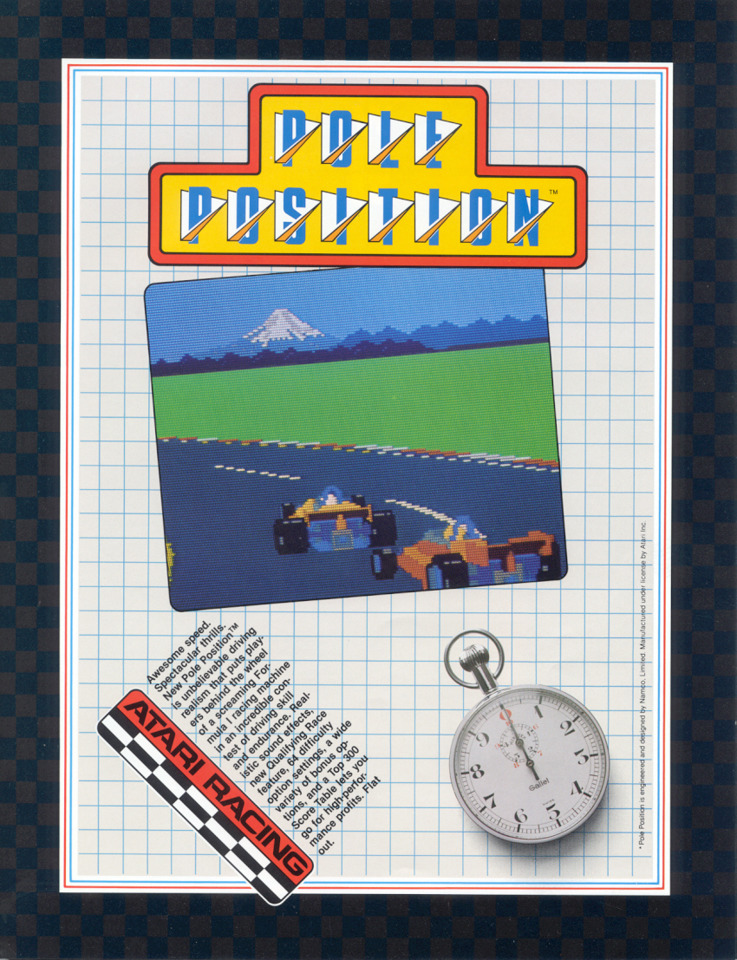
Namco seems to think well of Pole Position, which was released in July 1982 in Japan, but it found even greater success in the United States. Namco shopped Pole Position and Mappy around in late 1982 to both Midway and Atari; Midway elected to be the distributor for the latter, while Atari released the former into North American arcades in 1983. It would go on to become the top grossing machine in America that year, spawning a Saturday morning cartoon of all things. There was demonstrably a lot of money to be made on the back of Pole Position, and Atari were in a great spot to do that via porting the game to as many home consoles as possible.
Before we cover Atari ports, however, I would like to address our first and last stop on the Vectrex. This strange little console was released in 1982 by General Consumer Electronics, a company that would be bought out in full by Milton Bradley in 1983. That wound up being a fairly terrible year to buy a console manufacturer, what with it being the year of the fabled North American Video Game Crash and all, and after losing a great deal of money Milton Bradley was itself bought out by Hasbro. Hasbro would go on to purchase MB's arch rival Parker Brothers in the early 1990s, merging both companies into Hasbro games in 1998. Hasbro does not own the Vectrex family, however; rights reverted to Jay Smith, the system's creator, and Mr. Smith has been very generous with his creation. He has allowed for development of new software for the Vectrex on a royalty free basis, as well as duplication of original Vectrex software. This puts the Vectrex much more in line with European microcomputers than contemporary consoles in terms of licensing and current availability of software.
That's all very neat, but there's also fact that the Vectrex received one Namco port during its brief commercial lifespan, and that was a damn good conversion of Pole Position. Developed in-house by General Consumer Electronics and released at some nebulous point in 1983, this Pole Position conversion is the only port that had the wonderful glowy vector aesthetic that was the hallmark of the platform. The pace of the game, while not as brisk as the arcade original, still moves at a nice enough clip to give the feel of a race. The main drawback here is the digital input, though GCE has also taken a few liberties with the music here that I don't personally appreciate. All told, if you want to play a Namco game on a thirty five year old CRT that relies on an overlay for color, this is pretty decent.
As good as the Vectrex port is, my money is with the 2600 conversion. The wizards at General Computer Corporation were once again at the helm on this one, which hit store shelves in North America in August 1983. They made Pole Position run on a system that was intended to play Pong, and they manage to do so with shockingly few cuts.
The VCS has a paucity of input options by default. The CX10 and CX40 controllers featured a simple four-directional joystick and a single button. How to graft these inputs onto something like Pole Position? GCC arrived at a novel solution: seeing as the game was primarily about driving forward, the default state of the vehicle is to accelerate. Depressing the face button functions as the breaks. Steering is handled by pushing the stick left or right, and shifting is handled by pushing up or down. This control scheme was so economical that it would survive for decades, appearing with a few tweaks even in Sega's Super Monaco GP series on the Mega Drive.
Thus marks the end of our 2600 coverage here, at least insofar as completed and official releases are concerned. We will see one more prototype and perhaps some homebrew down the line, but Pole Position is the official end for us. Between March 1982 and October 1983, the VCS received ports of Pac-Man, Ms. Pac-Man, Galaxian, the game in question, and Dig Dug. Jr. Pac-Man (not a real Namco game) stumbled out of the gate sometime in 1986, a side effect of Atari's division. I've helpfully ranked these games for you on Giant Bomb dot com, and I can say with some certainty that Pole Position is the best Namco title on the platform.
The 5200 port, which arrived one month later, doesn't impress me as much. The background parallax layer scrolls in a much choppier manner than the simpler 2600 landscape, and the entire game feels a bit slower. It is bolstered by utilizing the analog input on the 5200 controller, though that does come with the sizable of using a 5200 controller with its non-self-centering stick and crummy overall design.
Pole Position also marks the end of our commercial 5200 coverage. I'd say it lands right in the middle of the pack, with its jittery visuals being the main thing holding it back from truly surpassing Pac-Man and Ms. Pac-Man on this ill-fated platform. That said, even the slightly dodgy sounding Dig Dug conversion for this console is not exactly bad, and I'd go so far as to say that the Namco games on the 5200 represent some of the best the system ever received in its natural life. I've also ranked them for you, right here.
We leave these classic ports of Pole Position with another misfit toy: Pole Position on the Mattel Intellivision. Recall the tale of Dig Dug's late arrival on the console? Pole Position shares the same story, and in fact it arrived so late that the engineers at INTV took the liberty of turning the game into something that, strictly speaking, was no longer Pole Position. Right at the jump the player is presented with a selection of four tracks, a feature only introduced in Pole Position II. A bit of a misnomer then.
Regardless, what you find here is a hideous looking version of Pole Position with surprisingly good sound. There's some desperate attempts at simulating effects like sprite scaling and rotation, but the best thing that I could say is that the objects on screen are at least legible enough to be easily avoided by your oncoming car. I have not played this on an actual Intellivision, but the system's controller supported a 16-directional digital input device and utilizing all of those defined points on the wheel/disk hybrid input thing would have given this something of a control edge over the digital inputs of the 2600 version, at least.
This does mark the end of Namco's Intellivision presence, and Pole Position gets the edge over Pac-Man on that platform to be the best of the three titles we've covered there. Here's my list to prove it.
Why no Famicom port? Recall that the first year of the Famicom's life featured a library of games developed solely by Nintendo, with Hudson entering the fray in July 1984 (though they had collaborated with Nintendo and Sharp on the June '84 release of Family BASIC). Namco was the second third party publisher on the platform, kicking things off with the September 1984 release of Galaxian. That was followed by Pac-Man, Xevious, and Mappy in November. What was Nintendo up to that November? Well, they released F-1 Race on the Famicom.
Look at this and tell me it was not directly inspired by Pole Position and its sequel, I goddamn dare you. I know nothing about any Namco developed conversion of Pole Position for the Famicom, but it's hard to not look at this and wonder if Nintendo basically took Namco's lunch money with this game (which, with some drastic changes, eventually arrived in the United States as Mach Rider). I'd go so far as to say that F-1 Race might have been the first rumbling of the eventual blood vendetta between Nintendo's Yamauchi and Namco's Nakayama, a war of personalities that led to accusations in the Japanese press, Namco going all in on NEC's PC Engine, and a series of black unlicensed cartridges in the United States.
Position's history in the Namco Museum is surprisingly short, and this is again likely due to issues in grafting its controls onto home console input device schemes. It landed alongside Pac-Man and Galaga on Namco Museum Volume 1 in 1995, about as high a billing as could be given one of these classic games by Namco. Pole Position supported the neGcon, a freak of nature controller that supported analog steering via physically torquing halves of the controller on an axis. I have not been able to try this input mode, and in fact it would not be available to me in any case as it requires playing NaMuVo1 on a system with a PlayStation controller bus, and I only have the PSN version of the compilation. That version is playable on three systems (PS3, PSP, and Vita) with analog inputs via sticks, but Pole Position does not register these as analog. So, you are forced to play this version of Pole Position in most cases with digital steering, and that should mean nothing but badness.
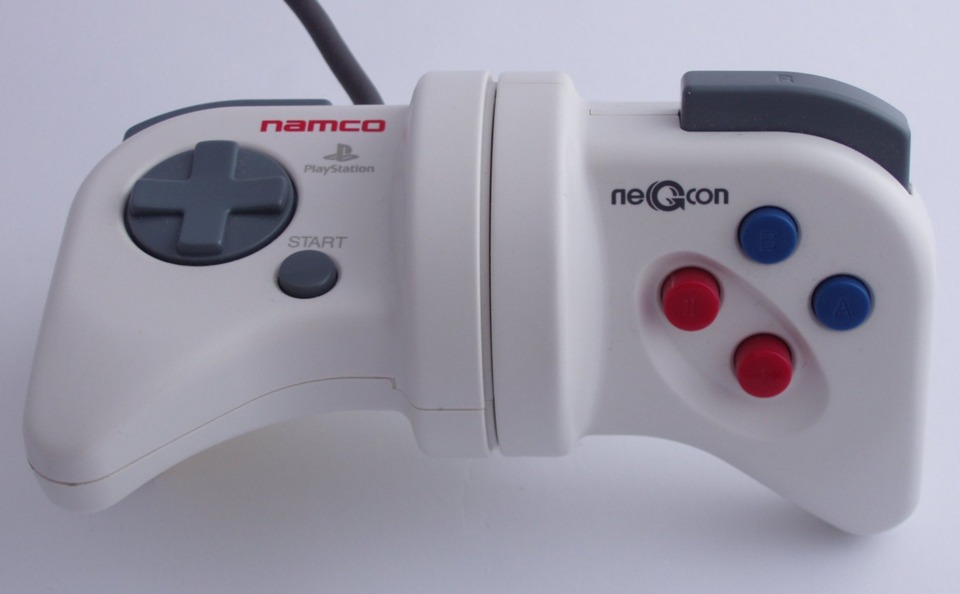
I would like to give the programmers at Namco some credit, however. While the digital input on this version of Pole Position is not going to satisfy everybody, it is a very earnest attempt to simulate actual steering. The length of your press on the left or right sides of the directional pad determine how hard you steer in either direction, and the car does not attempt to revert to driving straight immediately after letting off a direction. If you are trying to dial in a turn at a specific angle, you can coach yourself to pull off that angle and then release the pad. As it turns out this game moves at a brisk pace and you will often find yourself feathering the pad just to avoid driving into puddles, signs, other cars, or grass regardless. It is not perfect, but damned if Namco didn't try their hardest to make this work.
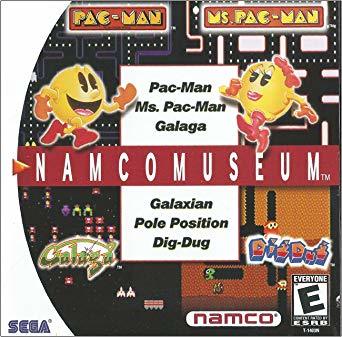
Next comes the helpfully named Namco Museum, released in basically two waves across multiple platforms. The first wave crashed onto the Dreamcast and Nintendo 64. Regretfully, I cannot find copies of either of these at local (well stocked) shops, and the N64 version's instruction manual does not specify whether or not the analog stick is used for steering in Pole Position. Wave two came to the Game Boy Advance, PS2, Xbox, and GameCube. The former of these four obviously operates on a d-pad and with some serious crunch to fit the GBA screen, while the home console versions supported analog and digital inputs. This scheme hold true for Namco Museum 50th Anniversary (2005 on PS2, Xbox and GCN), which was released on the GBA without Pole Position (it was replaced with Rally-X, because dot dot dot question mark).
Pole Position's most recent port of call was as part of Namco Museum Virtual Arcade for the Xbox 360. As one of the games that ran off the physical disc (opposed to being available on XBLA), Pole Position has no achievement support. It does feature analog input, making this a pretty good option, but no better the prior PS2/Xbox/GCN collections mentioned above.
If you were looking for a way to play Pole Position on a Nintendo console manufactured after 2001, you're shit out of luck. It is playable on a PSP or Vita, courtesy of NaMuVo1 being a PSOne Classic, but without the ability to experience the game with analog controls it is a compromised experience.
So, that's Pole Position. It's a wildly influential racing game, a technological arcade showpiece, and the home ports all range from good to great when you allow for some differences in control devices. Where's this Namco wagon train headed next? Back to kicking it with our favorite yellow pizza-shaped friend, who was about to receive his first Namco-developed sequel.
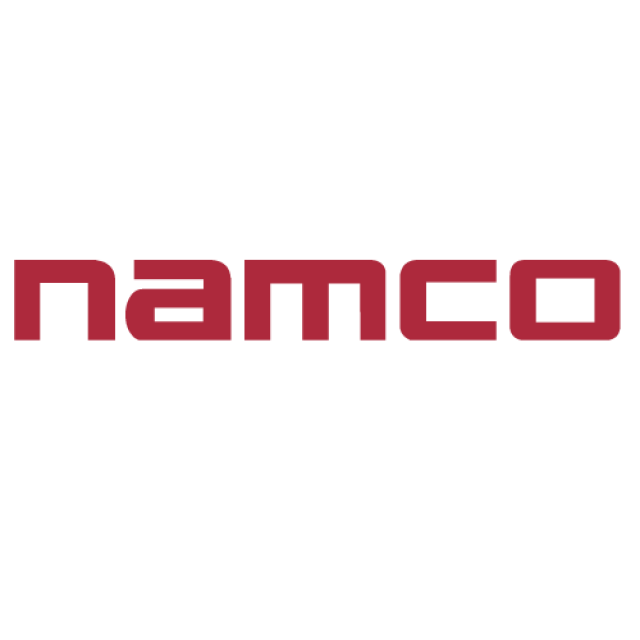
Log in to comment